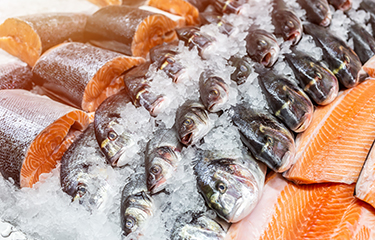Norway’s seafood exports continue to be impacted by the COVID-19 pandemic, with a double-digit percentage decrease in sales value in November.
Norway exported NOK 9.4 billion (USD 1.1 billion, EUR 878.1 million) worth of seafood products last month, representing a decrease of 11 percent or NOK 1.2 billion (USD 135.8 million, EUR 112.1 million) compared with November 2019, with the COVID-19 crisis continuing to affect trade, particularly for the salmon sector. For the 11-month period from January through November 2020, it has sold seafood valued at NOK 96.6 billion (USD 10.9 billion, EUR 9 billion) to overseas markets, which is a decrease of 1 percent or NOK 1 billion (USD 113.2 million, EUR 93.4 million).
According to the Norwegian Seafood Council (NSC) Director of Market Insight Tom-Jørgen Gangsø, the Scandinavian country’s seafood exports are now seeing the impact of a hotel and restaurant sector that has more or less shut down across Europe. At the same time, the demand for traditional items such as clipfish and stockfish – often eaten at larger dinners with friends and family – has fallen due to the restrictions on mixing households.
Gangsø said, in contrast, November 2019 was an “exceptionally strong month,” and that should also be taken into account when comparing year-on-year performance. Nevertheless, the fall in export value would have been greater if the Norwegian krone had not been so weak.
“The large Christmas sales of seafood this year must be covered by the retail trade, but it will not be enough to offset the loss of demand from the restaurants. A result of this is a significantly reduced price for most of the seafood products,” he said.
November’s salmon exports amounted to 108,000 metric tons (MT), an increase of 1 percent year-on-year, with Poland, France and Denmark providing the three largest markets. However, the value fell by 15 percent to NOK 5.8 billion (USD 656.2 million, EUR 541.8 million), with the average export price 19 percent lower at NOK 47.97 (USD 5.43, EUR 4.48) per kilogram.
“Due to the corona situation and a reduced turnover in the restaurant sector, salmon is not able to reach the record price highs we saw before Christmas last year. The fall in value could actually have been greater, but this is offset by increased sales of salmon fillets,” NSC Analyst Paul Aandahl said.
For the year to-date, 1 million MT of salmon was exported by Norway for NOK 64 billion (USD 7.2 billion, EUR 6 billion). While the volume is on par with the same period of last year, the value is down 2 percent, or NOK 1.6 billion (USD 181.1 million, EUR 149.5 million).
Over the same 11 months, it also shipped 66,000 MT of trout for NOK 3.6 billion (USD 407.6 million, EUR 336.4 million), representing year-on-year increases of 22 percent and 7 percent respectively.
In the whitefish sector, Norway exported 2,000 MT of fresh cod products worth NOK 94 million (USD 10.6 million, EUR 8.8 million) in November, down 32 percent and 33 percent, respectively. Also shipped was 6,800 MT of frozen cod, valued at NOK 276 million (USD 31.3 million, EUR 25.8 million), with the volume and value falling by 7 percent and 11 percent respectively.
For the year to-date, 46,000 MT of fresh cod and 65,100 MT of frozen cod have been sold to non-Norwegian markets, generating earnings of NOK 2.1 billion (USD 237.8 million, EUR 196.3 million) and NOK 2.9 billion (USD 328.4 million, EUR 271.1 million), respectively.
Also in this category, Norway has so far exported 74,700 MT of clipfish, earning NOK 3.9 billion (USD 441.6 million, EUR 364.5 million), representing a volume decrease of 13 percent, and a 12 percent reduction in value. This year’s saltfish trade currently has now reached 24,500 MT worth NOK 1.4 billion (USD 158.5 million, EUR 130.8 million), up 7 percent and 11 percent, respectively.
In regard to its main pelagic exports, Norway exported 49,000 MT of herring worth NOK 560 million (USD 63.4 million, EUR 52.3 million) last month, representing a volume decrease of 32 percent and a 4 percent lower value. Its mackerel exports, meanwhile, increased 45 percent in volume and 25 percent in value to 58,000 MT and NOK 928 million (USD 105 million, EUR 86.7 million), helped by a 40 percent increase in quota and strong consumer demand in markets such as Japan, South Korea, and Taiwan.
With declines seen across almost all of Norway’s seafood industry, Gangsø described the mackerel sector as the “bright spot,” thanks to its popularity in grocery channels.
“During the corona[virus] crisis, there has been increased demand for herring and mackerel, and we see that the export value for these species has already exceeded last year,” he said.
Norway’s shellfish sector exported a significantly larger 194 MT of king crab for NOK 65 million (USD 7.4 million, EUR 6.1 million) last month, thanks to increased demand coming from the United States and Europe.
With Alaska’s king crab quotas being low this autumn, exports of frozen king crab and snow crab to the United States are doing particularly well, the NSC said.
In the full-year 2019, Norway exported some 2.7 million MT of fisheries and aquaculture products, achieving record revenues of NOK 107.3 billion (USD 12.1 billion, EUR 10 billion).
Photo courtesy of Gorlov-KV/Shutterstock







